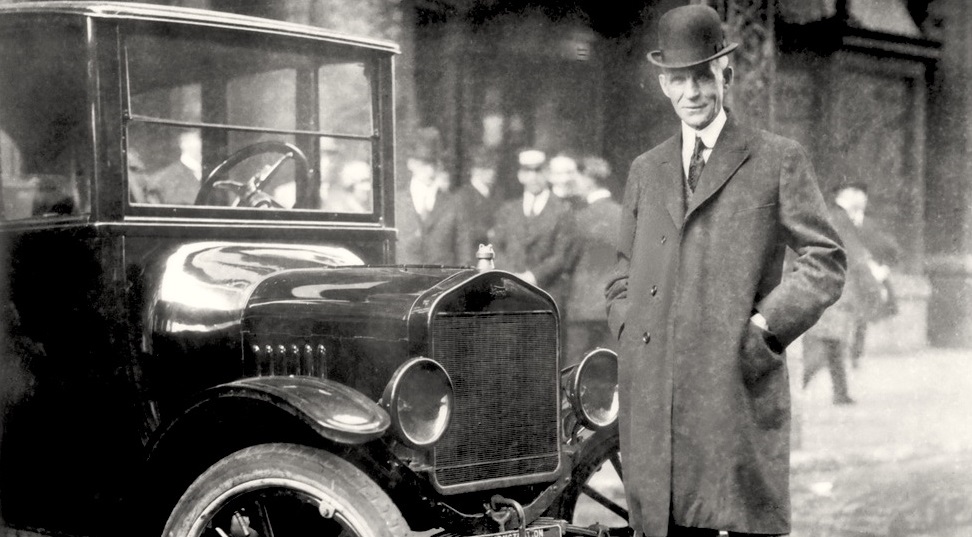It’s amazing to think it’s a little over a century since Henry Ford cracked the production model, making the car affordable to the mass market…
But what would Henry Ford think about how things have moved on today?
You could say nothing much changed until the 50’s & 60s, when technological innovations brought many changes in the automotive industry.
Some new concepts were, new look and feel of the cars, fiberglass bodies, higher compression ratio fuels, vehicle comfort, look and feel, emerging safety and environmental regulations, vehicle speed limits, front seat belts, heating, and ventilation equipment.
The 1970s brought low emission car technologies, such as catalytic converters and consumer interest in fuel-efficient vehicles increased due to high oil and fuel prices.
Globalisation came in the 90’s with huge overseas assembly plants built and many mergers taking place between large, multi-national car manufacturers.
This resulted in greater variety of products available for consumers to choose from and increased competition among the car manufacturers.
Increasing sophistication and empowerment of the consumer led to new and more specialised markets, further fueling global alliances and strategic partnerships with foreign automakers.
Industry revenue growth at the start of the millennium was very low compared to past decades, and skyrocketing fuel prices with growing environmental concerns shifted consumers’ preferences to more fuel-efficient cars.
The global economic crisis starting in 2007, led to financial troubles for many of the world’s largest car makers and rippled through other countries around the globe, causing unemployment to rise and wealth to dive.
General Motors was hit particularly hard, filing for Chapter 11 bankruptcy in June 2009, and due to less disposable income and growing pessimism about the future, demand for cars dropped.
So, in a century of advances and much turmoil, the motor car developed by Henry Ford, hadn’t really changed that much, had it?
Yes, safety, performance, comfort had been much improved, but they still rode on 4 wheels and were propelled by a combustion engine, measured in horsepower.
Although electric car technology was flirted with back the 90’s by General Motors and others (who never really took it seriously), it wasn’t until Elon Musk entered the industry that things changed.
Tesla was founded in 2003 with Musk saying, “the overarching purpose of Tesla Motors…is to help expedite the move from a mine-and-burn hydrocarbon economy toward a solar electric economy”.
And in 2017 he rubbed GM’s nose firmly in the dirt when he went on record as saying, “Tesla was started in response to GM’s cancellation of their electric vehicle program”.
So, not much change in technology for 100-years, then boom, Tesla go and rock the automotive world, with amazing electric car developments, bringing electric car technology mainstream.
To be honest, it’s probably what the automotive industry needed. Every now and gain we all need a kick up the backside to refocus our minds to get on with the task at hand.
The automotive industry has bumbled on for years further developing combustion engine technology, looking for governments to bail them out when things got a bit tight.
Now suddenly, it’s like they’ve been given a new lease of life, especially now with the likes of the UK government banning petrol and diesel new car sales from 2030 & new hybrid sales from 2035.
Coupled with the UK government putting in a grant scheme for both homes and workplaces, to help towards the cost of installing an electric car charger, it’s become a game changer for the industry.
It’s true, each person who lives in a house with off road parking and who has a qualifying electric or hybrid car, can claim £350 towards the cost of getting an electric car charger installed.
Works in a similar way for workplaces too.
If a business or organisation has designated parking places, they can claim £350 against the cost of each electric car charger they have installed, up to a maximum of 40 separate electric car chargers.
Some of the new electric vehicles coming out are amazing too, they’re safe, comfortable and their performance is amazing.
Just watch this space, early 2021 will see the launch of many new models from all the major manufacturers. Hyundai for sure will be releasing 5 new electric car models.
Two major concerns were range and cost, but have been addresses too.
Some electric vehicles already have a range of 300 miles or more, which is only set to get better as battery technology further develops, which I’m sure, will be seen is these new models.
Cost is an interesting argument.
The sales price for an electric vehicle is still higher that it’s combustion engine counterpart, until you take other factors into consideration, especially if you are a business with a fleet of vehicles.
You see, leasing an electric vehicle today will save the organisation money (in fuel and tax), and save the employees loads of cash in personal company car tax payments, against a petrol or diesel car.
And with the government providing grants of £350 for an electric car charger to be installed at both home and the workplace, all the barriers previously stopping you have now been removed.
So back to our original question. What do you think Henry Ford would think of things today?
Personally, we think if he was alive today, he and Musk will be best buddies, and Henry Ford might just be that person who helps to realise Musk’s dream of colonising Mars.
…but what do you think?


